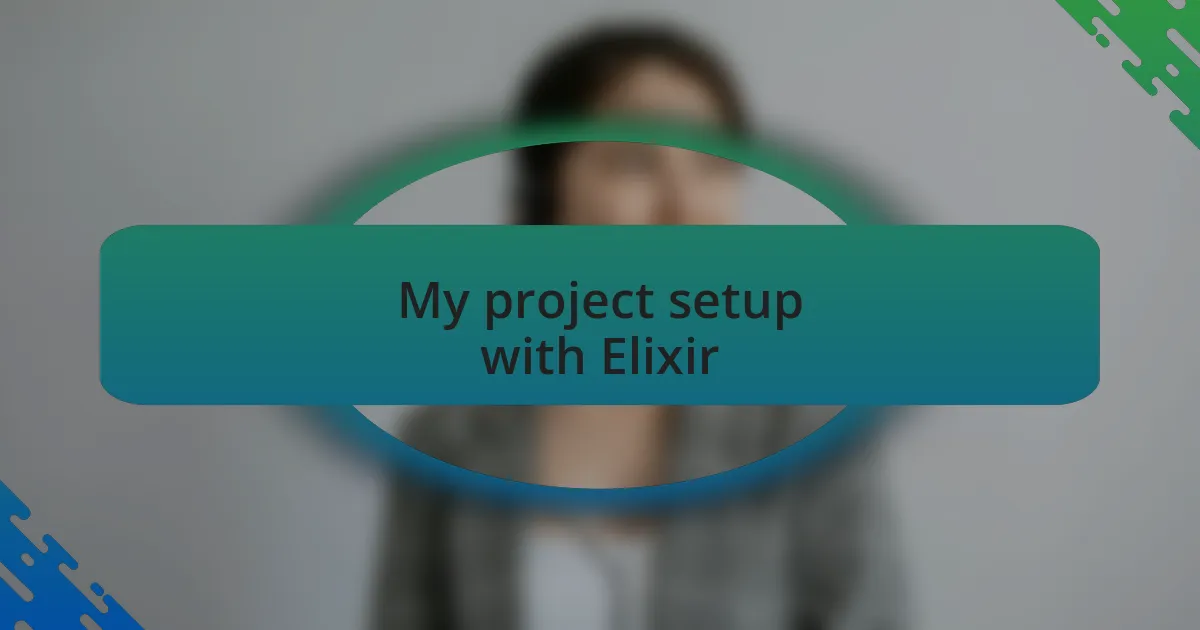Key takeaways:
- Elixir’s focus on immutability and functional programming leads to cleaner code and fewer bugs.
- The concurrency model and lightweight processes in Elixir enable seamless scaling and error recovery in web applications.
- Tools like Mix and built-in testing frameworks enhance workflow and code management, fostering better development practices.
- Engagement with the Elixir community provides valuable insights and support, promoting shared learning and collaboration.

Overview of Elixir language
Elixir, a dynamic, functional language built on the robust Erlang Virtual Machine (BEAM), really piqued my interest due to its impressive concurrency capabilities. I remember the first time I ran a reasonably complex application and watched it handle multiple connections effortlessly—it was like witnessing a well-choreographed dance of processes. It left me wondering, how could a language so concise manage to deliver such powerful performance?
One of the features that truly resonates with me is Elixir’s emphasis on immutability and functional programming. This approach shifts the way I think about building applications, allowing me to focus on pure functions that yield predictable results. Reflecting on my experiences, it feels liberating to write code free from side effects, and I can’t help but ask: How many bugs could we avoid if more languages embraced this philosophy?
Another standout aspect of Elixir is its integration with the Phoenix framework, which I find exhilarating. The first time I set up a real-time feature using channels, I felt a thrill that reminded me of building my first app. The seamless way Elixir handles websockets prompts the question—how does this language make complex tasks so delightfully simple? It’s those moments that reinforce my love for Elixir and fuel my passion for developing innovative web applications.

Benefits of using Elixir
Elixir’s concurrency model really stands out to me as a game-changer in web development. The first time I deployed an application that needed to support hundreds of simultaneous users, I felt a wave of relief when I saw it scale seamlessly. The actor model lets me think about processes as independent entities, which means that failures in one area don’t bring down the entire system. I often wonder, what if more developers understood the ease of error recovery that Elixir provides?
Another benefit I’ve experienced is how Elixir’s ecosystem encourages clean code and maintainability. I recall a project where the business logic evolved dramatically over time, and I was amazed at how easy it was to refactor without introducing bugs. The readability of Elixir’s syntax invites collaboration, inspiring discussions about best practices and design patterns that I cherish. Have you ever felt that sense of camaraderie among team members while working on a shared codebase?
Moreover, the performance of Elixir applications has consistently impressed me. During a recent project, I had to optimize a system that was sluggish under load. By leveraging features like lightweight processes and asynchronous calls, I not only improved response times but also reduced server costs significantly. It makes me think: isn’t it rewarding to create products that are both efficient and cost-effective?

Elixir for web application development

Elixir for web application development
Diving into web application development with Elixir has been quite an adventure for me. I recall the first time I used the Phoenix framework, which is built on Elixir. The real-time features blew me away! Building a chat application where users could exchange messages instantly made me appreciate how effortless it is to implement WebSocket support. Have you ever felt that thrill when your code comes to life right before your eyes?
What I find particularly fascinating about Elixir is how it excels in handling complex applications. On a recent project that involved integrating multiple APIs, Elixir’s lightweight processes made it easy to manage external calls without blocking the main application. By utilizing its powerful tools, I quickly realized that building resilient systems is less about avoiding errors and more about knowing how to gracefully recover from them. Isn’t it comforting to work with a language that empowers you to build for failure?
I often think about the community surrounding Elixir and how it fosters innovation in web development. Participating in forums and meetups has broadened my perspective on best practices and emerging trends. Just the other day, I exchanged ideas with a developer who shared insights on optimizing performance by leveraging Elixir’s concurrency for microservices. How often do we get that kind of enriching interaction in our tech journeys?

My project setup with Elixir
Setting up my Elixir project was surprisingly straightforward, which was a relief. I remember when I first ran the mix new command. It generated a clean project structure that felt organized and intuitive. The folder layout just made sense, allowing me to dive right into coding without feeling overwhelmed by complexity. Have you ever appreciated a tool that prioritizes simplicity?
As I started integrating dependencies using mix.exs, I was impressed by how seamless the process was. Adding the Phoenix framework felt like unlocking a treasure trove of features. I distinctly recall the moment I configured my routes, and everything clicked into place. It’s incredible when you see the results of your setup materialize so quickly—like unwrapping a gift filled with possibilities. The excitement of seeing your first page render with live reloading is hard to match, isn’t it?
In my experience, running the application with mix phx.server felt like flipping a switch. I still smile thinking about how the local server spun up, and in just seconds, I was greeted by the welcome screen. That instant feedback—seeing my browser load up the Elixir app—reinforced my choice to use this powerful language. Have you felt that sense of accomplishment when everything works as intended? It’s those moments that make all the setup worth it.

Challenges I faced with Elixir
One of the significant challenges I faced when using Elixir was the learning curve associated with functional programming concepts. Transitioning from an object-oriented mindset to understanding immutability and higher-order functions was like trying to grasp a new language. I remember staring at my code, wondering why I couldn’t treat data like I used to. It took time and persistence to appreciate the power of these concepts, and I often found myself asking, “Why is this so different?”
Another hurdle came when I started dealing with concurrent processes, a feature Elixir shines in. Initially, I struggled to comprehend how to manage processes effectively without causing chaos in my application. I vividly recall a day spent debugging what seemed like a straightforward concurrent task, only to realize it was the communication between processes that was tripping me up. It was like trying to orchestrate a symphony without understanding the instruments—frustrating, yet once I got the hang of it, rather rewarding.
The ecosystem also posed some challenges, especially when it came to finding libraries that fit my specific needs. While I appreciated Elixir’s growing community, I often found myself wading through documentation that felt sparse or incomplete. I can still picture the countless times I had to scratch my head over configuration issues or dependencies that didn’t play nicely together. It led me to wonder: is there a perfect library out there, or is it about making the best of what we have?

Solutions I found in Elixir
One of the standout solutions I found while using Elixir was its remarkable ability to handle concurrency through lightweight processes. I recall an instance where I was developing a chat application. When I implemented Elixir’s Actor model, I was astonished by how seamlessly messages flowed between processes. It felt almost magical to see features like real-time updates come to life, and it made me wonder: Could other languages achieve this level of simplicity without the overhead?
Another solution that truly enhanced my development experience was the power of pattern matching. I remember a project where I had to parse various types of data inputs. Using pattern matching in Elixir allowed me to write concise and readable code. Instead of relying on cumbersome if-else statements, I could directly match data structures, making my logic straightforward and cleaner. This not only saved me time but also gave me a sense of clarity in my work that I hadn’t felt in previous projects.
I also found that leveraging built-in testing frameworks, such as ExUnit, drastically improved my workflow. When a friend once told me that writing tests is as vital as writing code, I didn’t fully appreciate it until I started using Elixir’s tools. I remember one late night, diving into an elusive bug that had stumped me for hours. I wrote some tests to narrow down the issue, and just like that, the clarity I needed emerged from the fog. It struck me how vital testing is to software development, especially in a functional environment like Elixir, where understanding your code’s behavior is paramount.

Lessons learned from using Elixir
While working with Elixir, I learned the importance of immutability in state management. Early on, I faced challenges when trying to track changes in my application’s state. It took some time to fully appreciate how immutability prevents unexpected side effects, but once I embraced it, the clarity in managing state was liberating. I often found myself asking, “How could I have overlooked this advantage before?”
Another valuable lesson came from using Mix, Elixir’s build tool. I initially approached my project without fully leveraging its capabilities, which left me feeling somewhat scattered in organizing my code. After refining my workflow with Mix, I felt a sense of control and efficiency that transformed how I approached tasks. It felt like switching from using a simple toolbox to an engineered workstation, allowing me to focus more on coding rather than managing chaos.
Lastly, my experience with Elixir’s community has shown me the power of open collaboration. I remember attending a local Elixir meetup where developers shared their triumphs and pitfalls. Listening to others opened my eyes to how vital community engagement is in problem-solving and learning. It’s incredible to think: How much further could we progress if we shared our journeys more often?